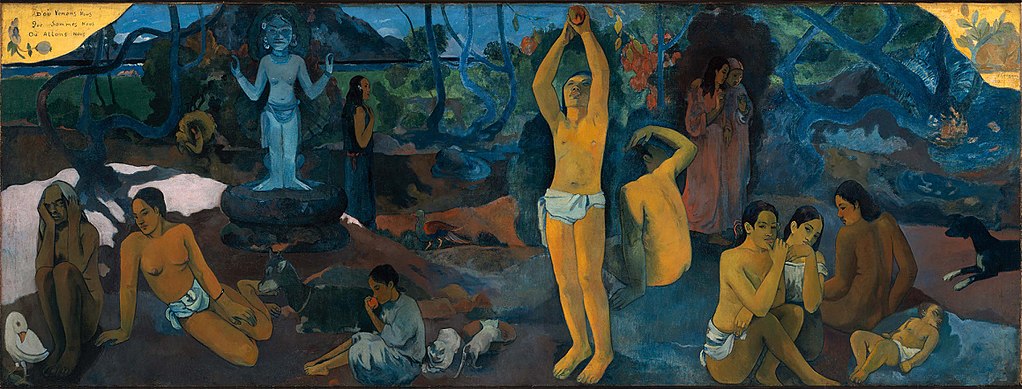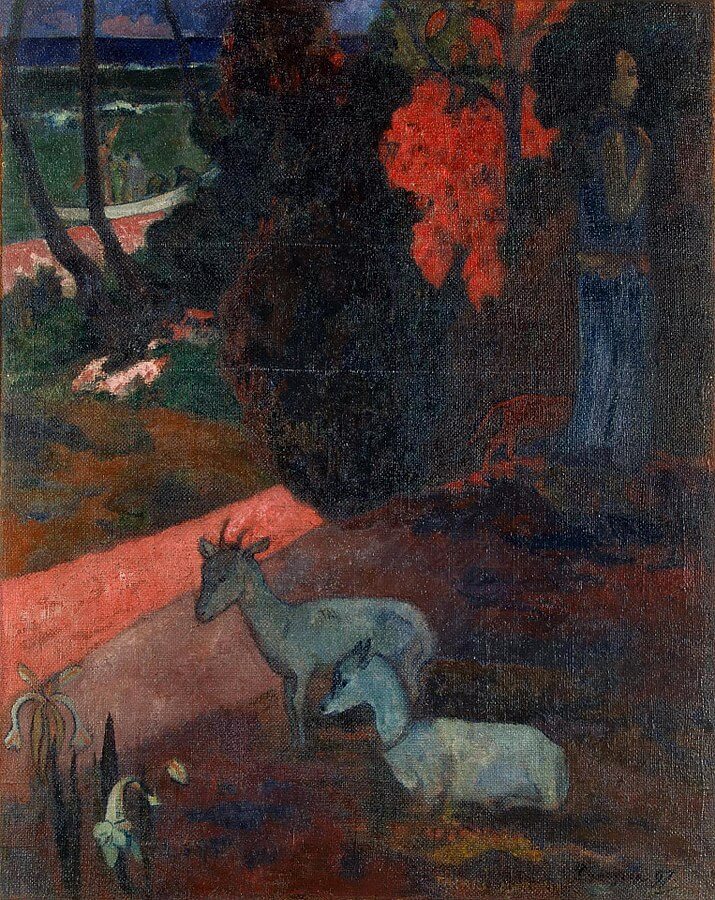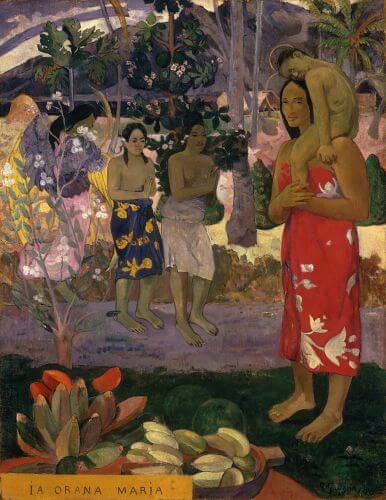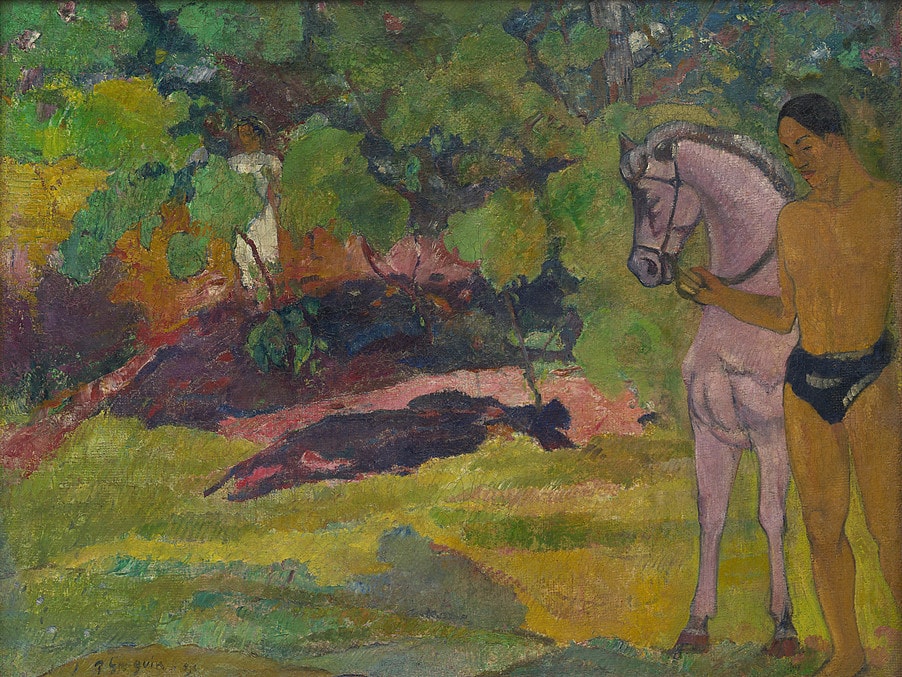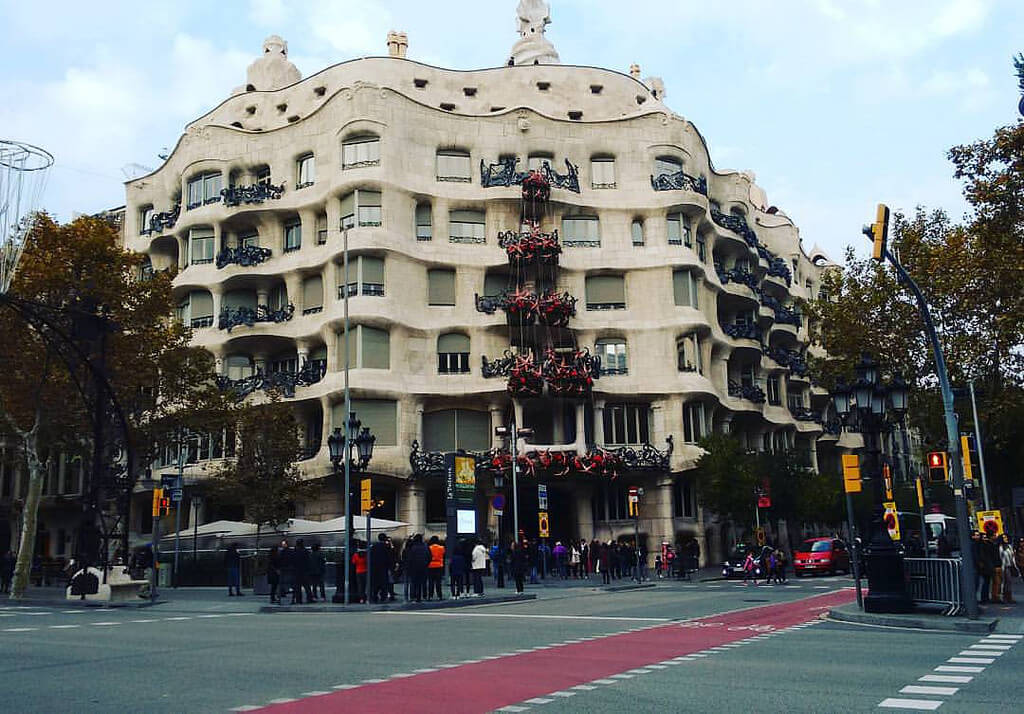|
Where? Gallery 255 of the Museum of Fine Arts
When? 1897-1898 What do you see? This painting shows a story on the cycle of life. It consists of three parts corresponding to the three questions in the title of the painting.
Backstory: The French title of this painting is D'où Venons Nous? Que Sommes Nous? Où Allons Nous? Gauguin included this title on the top left of the painting. A valuable source of information to understand this painting are the letters that Gauguin wrote to George-Daniel de Monfreid, an art collector and painter in France. Based on these letters, we know that when Gauguin started to work on this painting, he was in a dark period of this life. He faced quite some debt, bad health, the death of his favorite daughter, and he wanted to kill himself. However, before dying, he wanted to complete a large canvas about the meaning of life. For about one month, he worked day and night on the painting. When it was finished, he considered this to be his best work ever and wrote that he would never make a better painting. Some other works that he completed during this dark period of his life are the Landscape with Two Goats (also known as Tarari Maruru) and Man Picking Fruit from a Tree. After Gauguin completed the Where Do We Come From painting, he attempted suicide but failed at it. The painting was exhibited in 1898 in Paris and received mixed reviews. In 1901, the painting was sold for 2500 French Francs (which is equivalent to about $15,000 today).
Who is Gauguin? Eugène Henri Paul Gauguin was born in 1848 in Paris, France, and died in 1903 in French Polynesia. Gauguin is considered to be a Post-Impressionist artist, though his work differs from the Post-impressionists by the unique colors that he used and the feelings he expressed in his paintings. Just like paintings by Van Gogh, who was a friend of Gauguin, the works of Gauguin are often recognizable from a distance.
Gauguin was only a full-time artist during the last 20 years of his life. Until the crash of the French stock market and the art market in 1882, Gauguin was a successful stock and art broker, yearly making the equivalent of about $250,000 today. In 1891, he decided to move to Tahiti in French Polynesia where he stayed for two years. Upon his arrival, he created some of his famous paintings, like Hail Mary in the Metropolitan Museum of Art and In the Vanilla Grove, Man and Horse in the Guggenheim Museum in New York. After an unsuccessful return to France for two years, Gauguin returned to French Polynesia where he lived until his death.
Fun fact: This painting is featured in the book Origin (Amazon Link) by Dan Brown. In the book, the painting hangs in Casa Mila in Barcelona, which was a private house designed by Antoni Gaudí. The painting refers to the search for the existential questions of ‘where do we come from?’ and ‘where are we going?’. The painting by Gauguin does not answer these questions.
Gauguin kept the painting and symbolism in this painting quite vague to stimulate the viewer to think about these questions. That has certainly worked for some people in Dan Brown’s book as some characters are actively looking for the answers to these questions.
Written by Eelco Kappe
References:
2 Comments
darssana
11/5/2019 04:13:58 am
i just saw this article and im actually trying to figure out this answer too . im just in grade 10 and im 15 so any help regarding this is welcome . i want much more information about this painting . the thing that he painted this when he was in a dark period of his life is shocking . where did you get all this information from ??
Reply
Eelco Kappe
11/5/2019 12:02:29 pm
Hi Darssana,
Reply
Leave a Reply. |
Categories
All
|
- Home
- Blog
-
Museums
- Alte Pinakothek
- Art Institute of Chicago
- Baltimore Museum of Art
- Barber Institute of Fine Arts
- Bargello
- Barnes Foundation
- British Museum
- Church of Sant’Anastasia
- Cleveland Museum of Art
- Courtauld Institute of Art
- Detroit Institute of Arts
- Frans Hals Museum
- Galleria Borghese
- Gallerie dell'Accademia
- Getty Museum
- Guggenheim
- Hermitage Museum
- Kunsthistorisches Museum
- Kunstmuseum Basel
- Legion of Honor Museum
- Louvre
- Mauritshuis
- Metropolitan Museum of Art
- Musee d’Orsay
- Museum of Fine Arts in Boston
- Museum of Modern Art
- National Gallery in London
- National Gallery of Art
- National Museum in Poznań
- Norton Simon Museum
- Ny Carlsberg Glyptotek
- Palace of Versailles
- Palazzo Pitti
- Palazzo Vecchio
- Petit Palais
- Philadelphia Museum of Art
- Prado
- Pushkin Museum
- Ravenna Art Museum
- Rijksmuseum
- San Diego Museum of Art
- Santa Maria delle Grazie
- St. Peter's Basilica
- Städel Museum
- Statens Museum for Kunst
- Tate Britain
- Tate Modern
- Timken Museum of Art
- Uffizi
- Vatican Museums
- Wallace Collection
-
Artists
- Altdorfer
- Anguissola
- Berlin Painter
- Bosch
- Botticelli
- Boucher
- Bronzino
- Bruegel the Elder
- Brunelleschi
- Cabanel
- Caillebotte
- Canova
- Caravaggio
- Carpeaux
- Cezanne
- Cimabue
- David
- Degas
- Delacroix
- De Maria
- Donatello
- El Greco
- Fontana
- Fra Angelico
- Fragonard
- Gauguin
- Gentileschi
- Gericault
- Gonzalez-Torres
- Goya
- Hals
- Hogarth
- Hokusai
- Ingres
- Leonardo da Vinci
- Lippi, Filippo
- Longhi, Barbara
- Lorrain
- Makovsky
- Manet
- Massys
- Matisse
- Merian
- Michelangelo
- Mochi
- Modigliani
- Monet
- Panini
- Parmigianino
- Perugino
- Picasso
- Pisanello
- Raphael
- Rembrandt
- Renoir
- Reynolds
- Rivera
- Rodin
- Rubens
- Scultori
- Seurat
- Steen
- Tintoretto
- Titian
- Toulouse-Lautrec
- Turner
- Uccello
- Van der Weyden
- Van Dyck
- Van Eyck
- Van Gogh
- Van Hemessen
- Vasari
- Velazquez
- Vermeer
- Veronese
- Vigée Le Brun
-
Locations
- Books
- About Us

